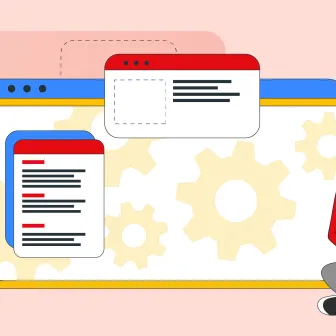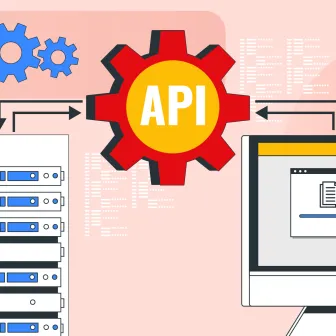The first Application Programming Interface (API) is said to be backed in the 60s, even before the personal computers, in the non-web form of libraries in operating systems. They provided information exchange between programs.
Cut short to this day, modern web-APIs offer full integration with DevOps, front-end and back-end development. They are divided into two parts of the meaning: web API or an API built using REST.
But what is an API? And how have they managed to travel this far in technology? What’s their evolution story?
Here’s a short, modern history of the web APIs that can unfold the evolution for you.

What is an API?
When you make a request to connect with any application on your devices, the process of interacting with the Internet, sending data to a server and retrieving readable information to the user is performed by the API.
It creates a connection that performs the necessary procedures for the actions to take place between the user and the devices.
For instance, when we try to book a flight at any of the third-party platforms like Expedia, the request is made to interact with the airlines’ APIs and fetch the necessary information to be reflected back to you. It is not directly interact with the site, rather it interprets that data and presents you with the necessary information. Over the years, modern API has evolved with extraordinarily valuable and useful characteristics that make it standardized, secure and monitored. They have their own development cycle that is well documented for versioning.
History of APIs
As IBM notes, the API timeline was born in the year 2000 with Roy Fielding and his published dissertation: Architectural Styles and Design of Network-based Software Architectures. While the concept was already known for over thirty years, Mr. Fielding made it official by getting it published.
Soon, with e-commerce becoming the first commercial beneficiary of this technology, eBay and Amazon made their mark by developing their own APIs. Amazon API granted its developers the ability to incorporate content and features from other sites. Inversely, other sites could also search and display inquiries from Amazon in XML format. However, the history of API was only taking small steps until 2005.
Over the years, APIs have evolved on the hinges of advances in technology from security to speed. Moreover, they are coming up with better business-enabling capabilities.
When APIs Surfaced to Rise
Evolving with time, APIs have become flexible and scalable. Among the early providers of API like Amazon and Twitter, Salesforce is said to produce the first web-based API. However, they still didn’t create a lot of noise. It was only around 2008, the dramatic rise of API came to the forefront of technology.
What made them surface above the level was the advent of cloud computing. Unlike the structured and rigid non-web APIs, they matured to a point where they can now provide a scalable capacity to handle transaction loads and traffic spikes.
Today, service-oriented architecture (SOA) are taking APIs to a new height. They are exposing a way for APIs where operations like request access, authorization, monitoring, analytics, and entitlement can take place.
Future with APIs
Now that we know APIs are here to stay, what does the future hold for them?
Increase in Business Agility
Agility is already a plus point for APIs as companies have been leveraging them to attain business goals. The future holds an extension of this agility as businesses will simply the IT architecture to avoid dependencies and migrate to APIs.
Expanding with Microservices Architecture
Microservices and their modular services will make a trend in API in the next two years by allowing developers the freedom to use API integration for API-relation innovation. With the ability to make applications deployable and secure, the microservices architecture will exploit their functionalities for good.
Integrating Private and Partner APIs
In order to maximize productivity and increase the value of current operations of applications, private APIs hold the potential to decrease the development time and resources required for the internal IT systems’ integration by building new ones.
On the other hand, partner APIs have the bandwidth to grant developers with access to the company. Along with business managers and designers, a new application can be built for the convenience of achieving goals.
IT Management Tools and Methods
APIs facilitate communication between management tools like DevOps and ChatOps. Here, the open APIs come to rescue with their agility to speed up and ease the setups by making the interactions minimum or zero with the owners of the API endpoints. This paves the way for smooth management, maintenance, and implementations for IT teams. They can optimize costs and performance for the organization and meet their needs with excellence.
Data Gathering
Today, organizations are adopting tools and programs to analyze data and spending extra time and money on it. Here, the APIs can be leveraged to fetch the source of data and eliminating the need for human interference. Automating this process leads to gaining large quantities of data from multiple sources and categorizing them in a consumable manner.
Conclusion
APIs have come a long way only because they kept up and expanded with the changes that marked their growth.
Currently, API teams require tools that can seamlessly implement and enhance the workflow without friction. In 2019, the teams look towards solving the challenge of standardization with collaborations and streamlining the API integration.
Share your thoughts on the topic on our social networks: Twitter, LinkedIn, and Facebook.
Subscribe
Related Blogs
AI Fairness: A Deep Dive Into Microsoft's Fairlearn Toolkit

Artificial intelligence (AI) has changed the game across industries, especially in financial services. From automating…
API Documentation Tool: 10 Best Tools For 2025

A Google search for ‘Best API Documentation Tool’ will show many results. The growing number of API documentation tools…
Debunking 6 Common Software Testing Myths

A flawless product delivery requires a perfect combination of both development and testing efforts. Testing plays a vital…




